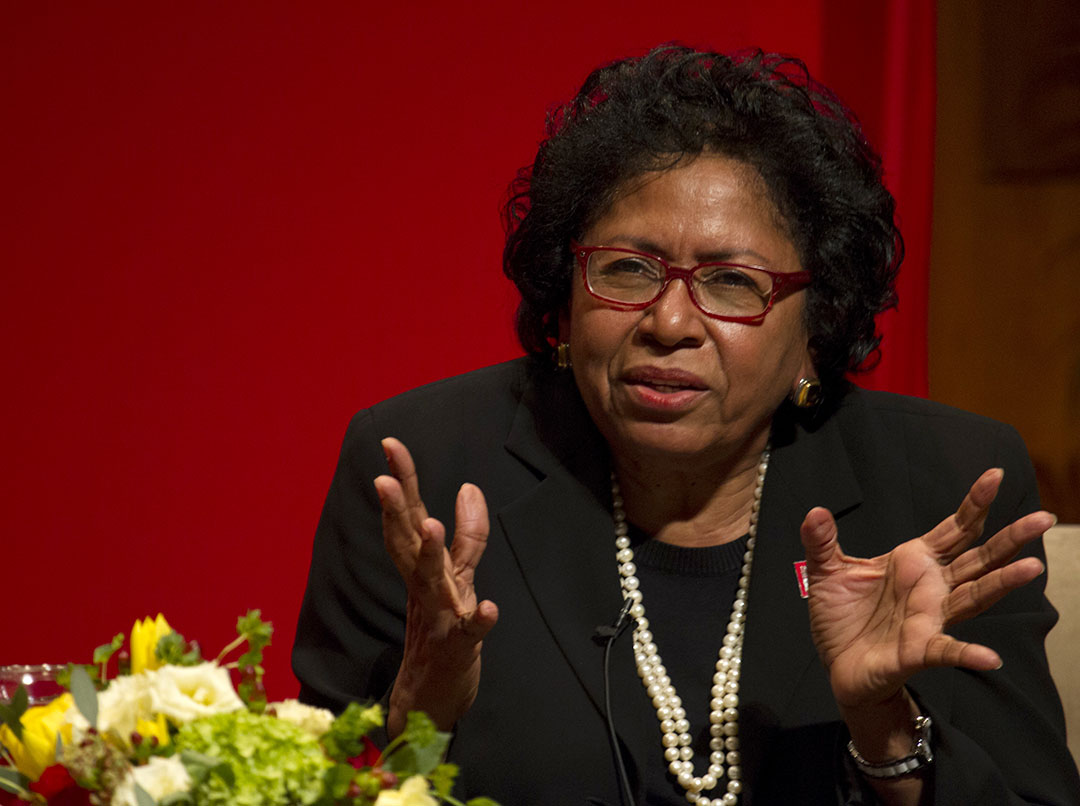
PROVIDENCE, R.I. [Brown University] — B. Anthony Bogues was among members of the Steering Committee for Slavery and Justice, appointed by then-President Ruth J. Simmons in 2003. He came to know Simmons well through the committee’s work, Bogues said, and he learned about what motivated her personally:
“Dr. Simmons believes in the public good and at the core of that public good is education and equal access to the best kind of education. For her, education is not simply about social mobility and citizenship, but about creating new possibilities. In that belief she follows a well-trodden African American preoccupation with education. I think it is safe to say that Dr. Simmons is a special kind of educational leader, one for whom education leadership is not a job but a vocation.”
Roughly a decade later, Bogues, now the Lyn Crost Professor of Social Sciences and Critical Theory, shared those recollections with an audience in the Salomon Center for Teaching’s De Ciccio Family Auditorium on Friday, Oct. 24, 2014. Simmons’ beliefs, Bogues said, drove the work of the steering committee, which would eventually produce a formal report on the University’s historical relationship to slavery and the transatlantic slave trade.

Among the report’s recommendations was the creation of a research center that would continue and expand the work of the steering committee. In 2012, the University followed through on the recommendation, establishing the Center for the Study of Slavery and Justice and appointing Bogues as its inaugural director.
The gathering at the Salomon Center — for alumni, students, faculty, and staff — was the dedication of the Center for the Study of Slavery and Justice and its new home.
Also present at the ceremony was Simmons, who took the podium after Bogues to deliver a lecture titled “Confronting Historic Wrongs: A University’s Dilemma.”
She was quick to give credit to the Brown Board of Trustees for approving the establishment of the Center, “although they were helped to see the wisdom of it,” she said, to much laughter.
Turning to the topic of the Center’s work, much of Simmons’ lecture was focused on the role of the university as a forum for debating issues of human rights and inequality. The years spent in college are often the only time in a person’s life that they get to hear discussion of such issues from multiple perspectives, Simmons said. Such debate, “prepares students to form opinions.”
The Center’s work will focus on issues of both the past and present, Simmons said.
The research of the Center “must evolve as new information comes to light and the winds of justice shift direction,” Simmons said. Later, she added that there is “little evidence that slavery in its current forms will soon disappear.”
Following Simmons’ lecture, the audience headed to the Center’s new home at 94 Waterman Street. It had spent its first two years in offices in Alumnae Hall. The first floor of its newly remodeled home includes a glass wall art piece titled “Rising to Freedom” that depicts movement from slavery to forms of freedom through a series of iconic images.
A gallery space will display both research and art. Currently on display is “Black Experiences at Brown,” part of Brown’s 250th anniversary celebration. It is an interactive exhibition that chronicles the history of African Americans at Brown.

Outside the building, a slave garden designed by Geri Augusto, visiting associate professor of Africana studies, is inspired by the gardens that enslaved Africans would grow by their living quarters. The garden features a stone cosmogram, a stone bench of contemplation, a bottle tree and a grassy flowered terrace.
At Friday's ceremony, guests passed through the house, stopping to take in the exhibition and garden before moving on to a large white tent on the adjacent green space.
Inside, Anani Dzidzienyo, associate professor of African studies, began the ceremony with a traditional African libation, which he described as a "connection with ancestors and spirits." As he spoke, he poured small amounts of water and rum onto the stage.
“It’s a connection back to continental Africa where a lot of this journey began,” he said.
Preston Tisdale ’73, president-elect of the Brown Alumni Association, spoke about the history of Brown’s first black graduates, including Inman Page, who was elected as class orator in 1877.
Bogues also referenced Page’s legacy in his remarks. Quoting from Page’s Commencement oration, Bogues said that history could be defined as “a past in the living present.” The work of the Center, Bogues said, would focus not only on the past, but how that past influences the present and future.
“History is about understanding action in human affairs. We are in a present space in which the past hovers like a specter.”
Note to Editors:
Editors: Brown University has a fiber link television studio available for domestic and international live and taped interviews, and maintains an ISDN line for radio interviews. For more information, call (401) 863-2476.